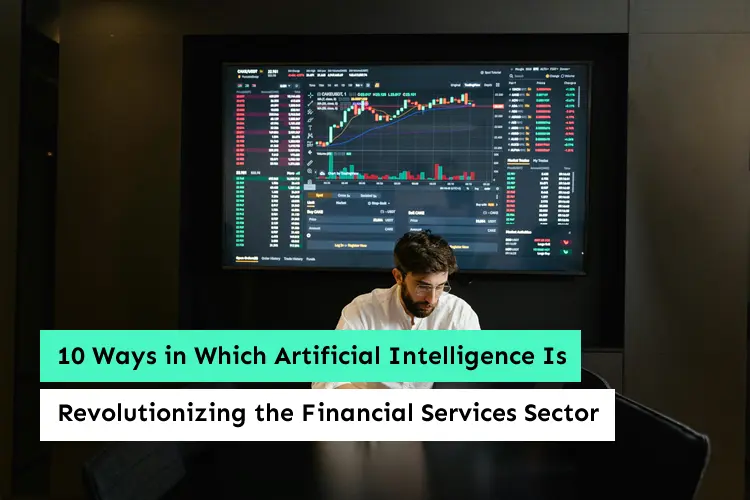10 Ways in Which Artificial Intelligence Is Revolutionizing the Financial Services Sector

Have you ever wondered how technology is reshaping the world of finance? As we navigate through the intricate web of financial transactions and investment strategies in today’s digital age, one cannot ignore the profound impact of technological innovations. From Artificial Intelligence (AI) revolutionizing risk management to Blockchain transforming the concept of trust, the financial services sector is undergoing a seismic shift unlike anything we’ve witnessed before.
Consider this: according to a report by Statista, global investment in AI in the financial services sector is projected to reach $26.5 billion by 2025, reflecting the growing importance of AI in driving efficiency, reducing risks, and enhancing customer experiences. Similarly, the cryptocurrency market, fueled by the rise of Blockchain technology, has surged to over $2 trillion in market capitalization, capturing the attention of investors and institutions worldwide.
In this dynamic landscape, the convergence of technology and finance is not just a trend; it’s a fundamental transformation that is reshaping how we manage money, make investment decisions, and interact with financial institutions. In this blog, we’ll explore the ten most impactful ways in which technology, particularly AI and Blockchain, is revolutionizing the financial services sector, paving the way for a more efficient, inclusive, and transparent financial ecosystem. So, fasten your seatbelts as we embark on a journey into the future of finance, where innovation knows no bounds and possibilities are limitless.
-
Enhanced Customer Service

AI-powered chatbots and virtual assistants are becoming ubiquitous in the financial industry. These intelligent systems can handle customer inquiries, provide personalized recommendations, and even execute transactions, offering round-the-clock assistance while reducing operational costs for financial institutions.
AI-Powered Chatbots and Virtual Assistants
Gone are the days of long wait times and cumbersome phone calls. AI-driven chatbots and virtual assistants now provide instant support to customers, addressing queries, processing transactions, and offering guidance round-the-clock. These intelligent systems leverage natural language processing (NLP) and machine learning algorithms to understand and respond to customer inquiries accurately.
Personalized Recommendations and Assistance
AI analyzes vast amounts of customer data, including transaction history, spending patterns, and investment preferences, to deliver personalized recommendations and assistance. Whether it’s suggesting suitable financial products, optimizing investment strategies, or providing budgeting advice, AI enables financial institutions to tailor their services to individual needs.
Efficiency and Accessibility
By automating routine tasks and inquiries, AI enhances the efficiency of customer service operations while ensuring accessibility to a broader customer base. Whether through web chat, mobile apps, or voice-activated assistants, customers can interact with financial institutions conveniently, anytime and anywhere.
Continuous Learning and Improvement
AI-powered customer service systems continuously learn from interactions and feedback, improving their accuracy and effectiveness over time. Through machine learning algorithms, these systems adapt to changing customer preferences and market dynamics, providing increasingly relevant and personalized support to users.
-
Personalized Financial Advice

AI algorithms analyze vast amounts of customer data to provide personalized financial advice tailored to individual needs and preferences. Whether it’s investment recommendations, budgeting strategies, or retirement planning, AI-driven insights help customers make informed decisions to achieve their financial goals.
Data-Driven Insights
AI algorithms analyze vast troves of customer data, ranging from transaction history and spending patterns to investment behavior and life events. By synthesizing this information, AI generates actionable insights into each customer’s financial situation, allowing financial institutions to offer targeted advice that aligns with their specific needs and aspirations.
Risk Profiling and Tolerance Assessment
Through sophisticated risk profiling techniques, AI assesses each customer’s risk appetite and tolerance levels. By considering factors such as age, income, investment experience, and financial goals, AI-powered systems can recommend appropriate investment strategies that strike the right balance between risk and return, ensuring optimal outcomes for clients.
Goal-Based Planning
AI facilitates goal-based financial planning by helping customers articulate their short-term and long-term objectives, whether it’s buying a home, saving for retirement, or funding education expenses. By understanding these goals, AI can devise personalized financial plans that outline actionable steps to achieve them, providing customers with a roadmap to financial success.
Behavioral Economics Insights
AI leverages insights from behavioral economics to understand and influence customer behavior. By nudging customers towards prudent financial decisions through personalized recommendations and incentives, AI helps foster positive saving and investing habits, empowering individuals to make sound financial choices that align with their long-term objectives.
-
Risk Assessment and Management

AI enables financial institutions to assess and manage risk more effectively. Machine learning models analyze historical data and real-time market trends to identify potential risks and predict future market fluctuations. This proactive approach helps mitigate risks and optimize investment strategies.
Data-driven Risk Models
AI algorithms ingest vast volumes of structured and unstructured data, including historical market trends, economic indicators, geopolitical events, and regulatory changes. By processing this data in real-time, AI-powered risk models can identify patterns, correlations, and anomalies that traditional risk assessment methods may overlook, providing a more comprehensive understanding of potential risks.
Predictive Analytics
AI employs advanced predictive analytics techniques to forecast future market trends, asset price movements, and creditworthiness. By leveraging machine learning algorithms, financial institutions can anticipate market fluctuations, assess credit risks, and identify potential vulnerabilities in their portfolios, enabling proactive decision-making to minimize exposure to adverse events.
Scenario Analysis and Stress Testing
AI facilitates scenario analysis and stress testing by simulating various hypothetical scenarios and assessing their potential impact on portfolios and financial markets. By conducting stress tests under different market conditions, AI helps financial institutions gauge their resilience to adverse events, identify potential vulnerabilities, and develop robust risk mitigation strategies.
Fraud Detection and Prevention
AI algorithms play a critical role in detecting and preventing fraudulent activities, such as identity theft, payment fraud, and money laundering. By analyzing transactional data and user behavior patterns, AI can flag suspicious activities in real-time, enabling financial institutions to take immediate action to mitigate potential losses and protect their customers’ assets.
Continuous Learning and Adaptation
AI-powered risk management systems continuously learn from new data and feedback, refining their models and algorithms to adapt to evolving market dynamics and emerging threats. By incorporating feedback loops and adaptive learning mechanisms, AI ensures that risk management strategies remain effective and responsive to changing conditions over time.
-
Fraud Detection and Prevention

Fraudulent activities pose a significant threat to the financial industry. AI algorithms can detect suspicious patterns and anomalies in transactions, flagging potential fraud in real time. By continuously learning from new data, AI systems improve their accuracy in identifying fraudulent behavior, safeguarding both customers and financial institutions.
Anomaly Detection Algorithms
AI-powered fraud detection systems utilize sophisticated anomaly detection algorithms to identify irregular patterns and suspicious behaviors within vast volumes of transactional data. By analyzing various parameters such as transaction frequency, location, amount, and user behavior, these algorithms can flag potentially fraudulent transactions in real time, minimizing the risk of financial loss.
Behavioral Biometrics
AI leverages behavioral biometrics, such as keystroke dynamics, mouse movements, and touchscreen interactions, to authenticate users and detect unauthorized access attempts. By analyzing subtle behavioral cues, AI-powered systems can distinguish between legitimate users and impostors, enhancing the security of online transactions and preventing identity theft and account takeover attacks.
Machine Learning Models
AI employs machine learning models to continuously learn from new data and adapt to evolving fraud patterns and tactics. By training on historical fraud cases and legitimate transactions, these models can detect emerging fraud trends, recognize new attack vectors, and refine their detection capabilities over time, staying one step ahead of fraudsters.
Network Analysis
AI conducts network analysis to uncover hidden connections and relationships between seemingly unrelated entities involved in fraudulent activities. By examining transactional networks, social networks, and communication patterns, AI can identify organized crime rings, money laundering schemes, and other sophisticated fraud schemes, enabling law enforcement agencies and financial institutions to dismantle criminal networks and disrupt illicit activities.
Multi-layered Fraud Prevention Strategies
AI-powered fraud detection systems employ multi-layered approaches, combining rule-based systems, machine learning algorithms, and advanced analytics techniques to detect and prevent fraud across multiple channels and touchpoints. By integrating disparate data sources and detection methods, these systems provide comprehensive fraud prevention coverage, reducing false positives and minimizing disruption to legitimate transactions.
-
Algorithmic Trading

AI-powered algorithms execute trades at lightning speed, leveraging vast amounts of data to identify profitable opportunities in the market. Machine learning models analyze market trends, news sentiment, and other relevant factors to make split-second trading decisions, maximizing returns and minimizing risks for investors.
High-Frequency Trading (HFT)
AI-driven algorithms enable High-Frequency Trading (HFT), where trades are executed at lightning speed to capitalize on fleeting market opportunities. By leveraging real-time market data feeds, AI algorithms analyze price movements, order book dynamics, and market liquidity to identify profitable trades and execute them with split-second precision, enabling traders to exploit microsecond-level inefficiencies in the market.
Machine Learning Predictive Models
AI employs machine learning predictive models to forecast future price movements and identify trading opportunities. By analyzing historical market data, news sentiment, and macroeconomic indicators, these models can predict short-term price fluctuations with remarkable accuracy, enabling traders to anticipate market trends and adjust their strategies accordingly, maximizing returns and minimizing risks.
Quantitative Analysis and Statistical Arbitrage
AI-powered algorithms conduct quantitative analysis and statistical arbitrage to exploit mispricings and inefficiencies in the market. By analyzing historical price data and identifying patterns and correlations, these algorithms can identify arbitrage opportunities and execute trades to profit from price disparities between related assets, such as stocks, options, and futures contracts, generating alpha for investors.
Automated Execution and Risk Management
AI automates trade execution and risk management processes, enabling traders to execute trades at optimal prices and manage portfolio risk more effectively. By setting predefined rules and parameters, AI algorithms can execute trades based on predefined criteria, such as price thresholds, volume limits, and risk constraints, ensuring disciplined and systematic trading strategies that minimize losses and maximize returns.
Adaptive Strategies and Market-Making
AI-driven algorithms adapt to changing market conditions and adjust trading strategies in real-time to optimize performance. By continuously learning from new data and feedback, these algorithms can dynamically adjust parameters, such as order sizes, execution times, and liquidity provision levels, to maintain competitiveness and profitability in rapidly evolving market environments.
-
Credit Scoring and Underwriting

Traditional credit scoring models often rely on limited data, leading to inaccurate risk assessments. AI algorithms analyze a broader range of data sources, including social media activity and transaction history, to assess creditworthiness more accurately. This enables financial institutions to offer loans and credit to a wider range of customers while minimizing default risks.
Comprehensive Data Analysis
AI algorithms analyze a broad range of data sources, including traditional credit bureau data, alternative data, and behavioral information, to assess the creditworthiness of borrowers more comprehensively. By considering factors such as payment history, income stability, employment status, and spending patterns, AI-powered credit scoring models provide a more holistic view of borrowers’ financial health, enabling lenders to make more informed lending decisions.
Predictive Modeling
AI employs predictive modeling techniques to forecast the likelihood of default and predict future credit behavior. By analyzing historical loan performance data and identifying patterns and correlations, AI algorithms can assess the risk profile of borrowers and assign credit scores that accurately reflect their creditworthiness. This enables lenders to tailor loan terms and pricing based on individual risk profiles, optimizing risk-adjusted returns and minimizing default losses.
Alternative Credit Scoring
AI enables lenders to extend credit to underserved populations by leveraging alternative credit scoring methodologies. By analyzing non-traditional data sources, such as utility payments, rental history, and social media activity, AI algorithms can assess the creditworthiness of individuals with limited credit histories or no credit history at all. This promotes financial inclusion and enables more individuals to access credit on fair and transparent terms.
Real-time Decisioning
AI facilitates real-time credit decision-making by automating underwriting processes and streamlining loan approvals. By integrating AI-powered decision engines into lending platforms, lenders can assess loan applications instantly, approve loans faster, and provide borrowers with a seamless borrowing experience. This not only enhances customer satisfaction but also reduces operational costs and improves efficiency for lenders.
Continuous Learning and Adaptation
AI-powered credit scoring models continuously learn from new data and feedback, refining their algorithms and improving their accuracy over time. By incorporating feedback loops and adaptive learning mechanisms, these models can adapt to changing market conditions, emerging trends, and evolving borrower behaviors, ensuring that credit decisions remain relevant and reliable in dynamic environments.
-
Automated Compliance and Regulation

Compliance with regulatory requirements is a critical aspect of the financial services industry. AI-powered systems streamline compliance processes by automatically monitoring transactions, detecting potential violations, and ensuring adherence to regulatory standards. This reduces the burden on compliance teams and minimizes the risk of regulatory penalties.
Regulatory Monitoring and Surveillance
AI-powered compliance systems monitor and analyze vast volumes of transactional data, communication records, and market activities to detect potential violations of regulatory requirements. By applying natural language processing (NLP) and machine learning algorithms, these systems can identify suspicious activities, market abuse, and insider trading behaviors, enabling compliance teams to take timely action to mitigate risks and ensure regulatory compliance.
KYC (Know Your Customer) and AML (Anti-Money Laundering) Compliance
AI automates KYC and AML compliance processes by verifying customer identities, screening transactions for suspicious activities, and monitoring for potential money laundering activities. By analyzing customer data, transactional patterns, and external risk factors, AI-powered systems can flag high-risk transactions and individuals for further investigation, enabling financial institutions to fulfill regulatory obligations and mitigate financial crime risks.
Transaction Monitoring and Reporting
AI facilitates transaction monitoring and reporting by automating the detection and reporting of suspicious transactions to regulatory authorities. By applying machine learning algorithms to analyze transactional data in real-time, these systems can identify anomalous behaviors, unusual patterns, and potential compliance breaches, enabling financial institutions to generate accurate and timely reports to regulatory agencies and regulatory bodies.
Automated Risk Assessments and Compliance Audits
AI conducts automated risk assessments and compliance audits to evaluate the effectiveness of internal controls and adherence to regulatory standards. By analyzing audit trails, transaction logs, and compliance documentation, AI-powered systems can identify gaps, weaknesses, and areas of non-compliance, enabling financial institutions to address deficiencies proactively and implement corrective measures to strengthen compliance frameworks.
Regulatory Change Management
AI assists financial institutions in managing regulatory changes by monitoring regulatory updates, analyzing regulatory texts, and assessing the impact of regulatory changes on business operations. By leveraging natural language processing (NLP) and machine learning algorithms, AI-powered systems can interpret complex regulatory requirements, identify relevant changes, and facilitate compliance adaptation efforts, ensuring that financial institutions remain compliant with evolving regulatory landscapes.
-
Predictive Analytics for Portfolio Management

AI-driven predictive analytics empower portfolio managers to make data-driven investment decisions. Machine learning algorithms analyze historical market data, macroeconomic indicators, and geopolitical events to forecast asset price movements and optimize portfolio allocations. This proactive approach helps maximize returns and minimize portfolio volatility.
Data-driven Insights
AI algorithms analyze vast amounts of historical market data, including price movements, trading volumes, and macroeconomic indicators, to identify patterns and trends that can inform investment decisions. By leveraging machine learning techniques, these algorithms can uncover hidden insights and correlations in the data, enabling portfolio managers to make more informed and data-driven investment decisions.
Market Forecasting
AI facilitates market forecasting by predicting future price movements and identifying potential market trends. By analyzing historical data and real-time market signals, AI-powered models can generate forecasts for asset prices, volatility levels, and market trends, enabling portfolio managers to anticipate market shifts and adjust their investment strategies accordingly to capitalize on opportunities and mitigate risks.
Risk Management
AI enables advanced risk management techniques by assessing portfolio risk and identifying potential vulnerabilities. By analyzing factors such as asset correlations, volatility levels, and macroeconomic indicators, AI-powered risk models can quantify portfolio risk exposures and simulate various scenarios to assess the potential impact of adverse events. This allows portfolio managers to implement risk mitigation strategies, such as diversification and hedging, to protect portfolio value and minimize downside risks.
Optimization Strategies
AI optimizes portfolio allocations by identifying optimal investment strategies that maximize returns while minimizing risks. By leveraging optimization algorithms, AI-powered portfolio management systems can identify the most efficient portfolio allocations based on predefined investment objectives, risk preferences, and constraints. This enables portfolio managers to achieve better risk-adjusted returns and improve portfolio performance over time.
Dynamic Asset Allocation
AI enables dynamic asset allocation strategies by continuously monitoring market conditions and adjusting portfolio allocations in real-time. By incorporating market forecasts, risk assessments, and investment constraints, AI-powered portfolio management systems can dynamically rebalance portfolios to capitalize on emerging opportunities and adapt to changing market dynamics, ensuring that portfolios remain aligned with investment objectives and risk preferences.
-
Customer Segmentation and Targeted Marketing

AI algorithms segment customers based on their behavior, preferences, and demographics, enabling financial institutions to deliver targeted marketing campaigns more effectively. By personalizing marketing messages and offers, AI helps attract new customers, enhance customer engagement, and increase conversion rates.
Data-driven Segmentation
AI algorithms analyze vast amounts of customer data, including demographic information, transaction history, online behavior, and social media interactions, to segment customers into distinct groups based on shared characteristics and preferences. By leveraging machine learning techniques, these algorithms can identify patterns and clusters in the data, enabling financial institutions to create meaningful segments that reflect the diversity of their customer base.
Personalized Marketing Campaigns
AI enables personalized marketing campaigns by tailoring messages, offers, and content to the specific needs and interests of individual customers. By leveraging customer segmentation insights, AI-powered marketing platforms can deliver targeted messages through various channels, such as email, social media, and digital advertising, maximizing relevance and engagement while minimizing wastage.
Behavioral Analysis and Predictive Modeling
AI conducts behavioral analysis and predictive modeling to anticipate customers’ future needs and preferences. By analyzing past interactions, transaction patterns, and engagement metrics, AI algorithms can identify signals and trends that indicate customers’ intent and propensity to purchase. This enables financial institutions to proactively target customers with relevant offers and recommendations, increasing the likelihood of conversion and customer satisfaction.
Cross-selling and Upselling Opportunities
AI identifies cross-selling and upselling opportunities by analyzing customer segmentation data and transaction history. By understanding customers’ preferences and purchasing behaviors, AI-powered recommendation engines can suggest additional products and services that align with their needs and interests, increasing revenue opportunities and enhancing customer lifetime value.
Real-time Personalization
AI enables real-time personalization by dynamically adapting marketing messages and offers based on customers’ interactions and behaviors. By leveraging real-time data streams and predictive analytics, AI-powered marketing platforms can deliver personalized experiences in the moment, such as targeted product recommendations, promotional offers, and content suggestions, driving immediate engagement and conversion.
-
Blockchain and Cryptocurrency

While not strictly AI, blockchain technology, often associated with cryptocurrencies like Bitcoin, is transforming aspects of the financial services sector. AI-powered algorithms are being used to analyze blockchain data, detect fraudulent transactions, and enhance security in cryptocurrency exchanges. Additionally, AI-driven trading bots are increasingly used in cryptocurrency markets to automate trading strategies and optimize returns.
Decentralized Ledger Technology
At the heart of Blockchain technology lies the concept of a decentralized ledger, which records transactions securely and transparently across multiple nodes in a network. By distributing transaction data across a decentralized network of computers, Blockchain eliminates the need for intermediaries and central authorities, reducing the risk of fraud, censorship, and manipulation.
Cryptocurrencies as Digital Assets
Cryptocurrencies, such as Bitcoin and Ethereum, are digital assets that utilize Blockchain technology to enable peer-to-peer transactions without the need for intermediaries. By leveraging cryptographic techniques and consensus mechanisms, cryptocurrencies provide a secure and efficient means of transferring value globally, facilitating cross-border payments, remittances, and micropayments with low fees and fast settlement times.
Smart Contracts and Decentralized Applications (DApps)
Blockchain platforms, such as Ethereum, enable the creation of smart contracts, which are self-executing contracts with predefined rules and conditions encoded on the Blockchain. Smart contracts enable automated and trustless transactions, facilitating a wide range of decentralized applications (DApps) across various industries, including finance, supply chain, and governance.
Tokenization of Assets
Blockchain technology enables the tokenization of real-world assets, such as real estate, securities, and commodities, by representing them as digital tokens on a Blockchain. By digitizing assets and fractionalizing ownership, Blockchain enables greater liquidity, accessibility, and efficiency in asset trading and investment, opening up new opportunities for fractional ownership and democratizing access to investment opportunities.
Decentralized Finance (DeFi)
Decentralized Finance (DeFi) platforms leverage Blockchain technology to provide financial services, such as lending, borrowing, and trading, without the need for traditional intermediaries. By eliminating barriers to access and leveraging programmable smart contracts, DeFi platforms offer greater transparency, security, and efficiency in financial transactions, enabling greater financial inclusion and empowerment.
Conclusion
Artificial Intelligence is revolutionizing the financial services sector in numerous ways, from improving customer service and risk management to enabling personalized financial advice and algorithmic trading. As AI technologies continue to advance, we can expect further innovations that will reshape the industry, making financial services more efficient, accessible, and secure for consumers and businesses alike.
We’re honored to mention that our efforts have been recognized by renowned B2B review and research platforms such as GoodFirms, Clutch, MirrorView, and many more.
Want more information about our services?
Similar Posts

How To Convert Your Impressive Idea Into An Impressive App That Users Love
You must have a website developed for your business; that’s why you know how web development projects work. But when it comes to app development, you are maybe not that sure. And it is okay to feel a little confused if you have never ventured into building an app business or an app for your […]...

The Future of Online Shopping: Personalized Assistance with ChatGPT
The world of e-commerce has seen tremendous growth over the past few decades, with more and more consumers opting to shop online for convenience, variety, and competitive pricing. However, as online shopping continues to evolve, so do consumer expectations. One of the key trends shaping the future of e-commerce is the integration of artificial intelligence […]...

Why PHP Laravel Framework is the Best
Picking a PHP development framework for developing web applications with can be a daunting and challenging task considering that there are currently so many options to consider. Nevertheless, some frameworks have proven themselves to be reliable when it comes to web development. One such framework is Laravel. In this article, we will be looking at […]...






